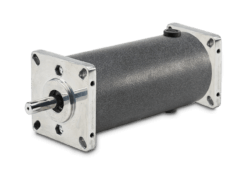Speed, torque, power and voltage are all important considerations when choosing a motor. In this two-part blog, we’ll dive into the specifics of motor speeds. In Part 1, we’ll discuss how speed differs between motor types, and in Part 2, we’ll look at when to consider adding a gearbox to the application.

AC Induction Motor Speeds
AC motors are unique because they are built to run at specific speeds regardless of their design or manufacturer. The speed of an AC motor is dependent on the number of poles it has and the line frequency of the power supply, not on it’s voltage. Common AC motor units are constructed with either two or four poles. A magnetic field is created in the stator poles that induces resulting magnetic fields in the rotor which follow the frequency of the changing magnetic field in the stator. Two pole AC motors operating at 60 Hz will always run at approximately 3600 rpm, and four pole AC motors will have speeds around 1800 rpm.
Speed = 120 x frequency (Hz) / poles of the motor
Example 120 x 60 hertz / 4 poles = 1,800 rpm.
Keep in mind that the speed of an AC motor will not run at these exact numbers—and will be slightly lower—because there is a certain amount of slip that must be present for the motor to produce torque. The rotor will always rotate slower than the magnetic field of the stator and is playing a constant game of catch up. This produces the torque to get an AC motor running. The difference between the synchronous speeds of the stator (3600 and 1800 rpm) and the actual operating speed is called slip. (For more information on slip, check out our blog Synchronous & Induction Motors: Discovering the Difference.)
A control can be used to alter the speed of a three phase AC motor by increasing or decreasing the frequency that is sent to the motor, causing it to speed up or slow down. Additionally, many AC controls have a single phase input so this allows you to run 3 phase motors in facilities that don’t have 3 phase power available.
However, this ability to alter the speed isn’t typically the case for single phase AC motors. These motors are plugged directly into a standard wall outlet and operate using the set frequency available. An exception to this rule of thumb would be a ceiling fan that runs using single phase AC motor, but has three different speed settings.
 DC Motor Speeds
DC Motor Speeds
Although permanent magnet DC motors are also built with poles, these poles don’t impact speed like with AC motors because there are several other factors in play with DC motors. The number of wire turns in an armature, the operating voltage of the motor, and the strength of the magnets all affect motor speed. If a DC motor is running on a 12 V battery, that is the maximum voltage available to the unit and the motor will only be able to perform at a speed rated for 12 V. If the battery is low and supplying less voltage, the speed will decrease accordingly.
Now, if you connect that same 12 VDC motor into a 24 VDC power source, your speed typically doubles. Keep in mind, operating the motor at twice the speed at the same load/torque point will cause the motor to work harder, creating additional heat that could cause premature motor failure over time.
As with three phase AC and Brushless DC motors, controls can be used with DC motors. DC controls adjust speed by varying the voltage sent to the motor (this differs from AC motor controls which adjust the line frequency to the motor).
Typical no load or synchronous speeds for an AC fractional horsepower motor are 1800 or 3600 rpm, and 1000-5000 rpm for DC fractional hp motors. If an application calls for a slower speed and/or higher torque, then a gear motor should be considered. To learn more about adding a reducer, check out Part 2, “Motor Speeds Explained: When to Use a Gearbox.”


